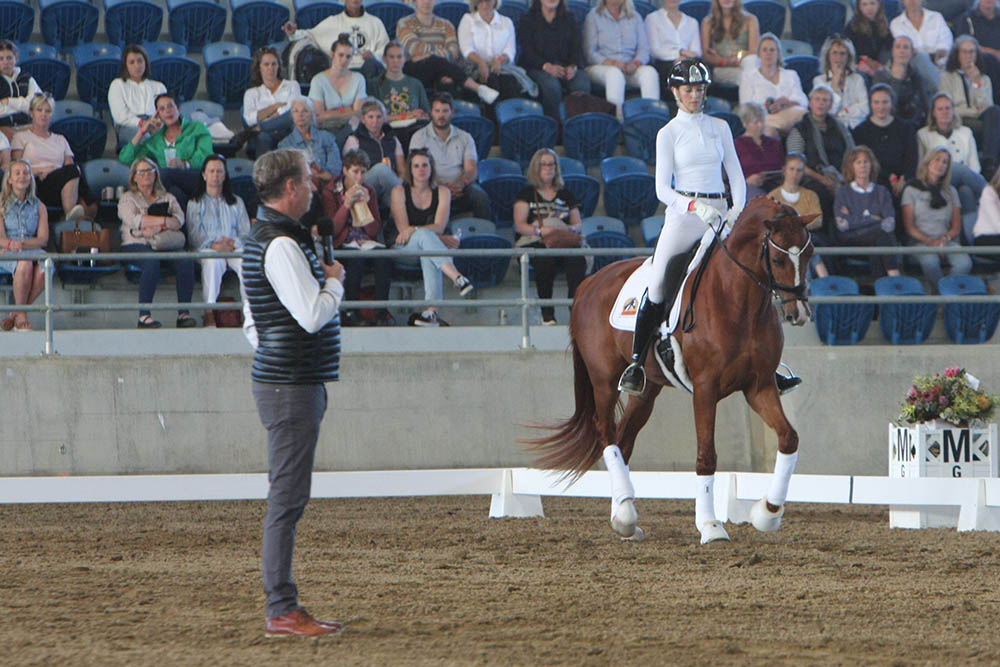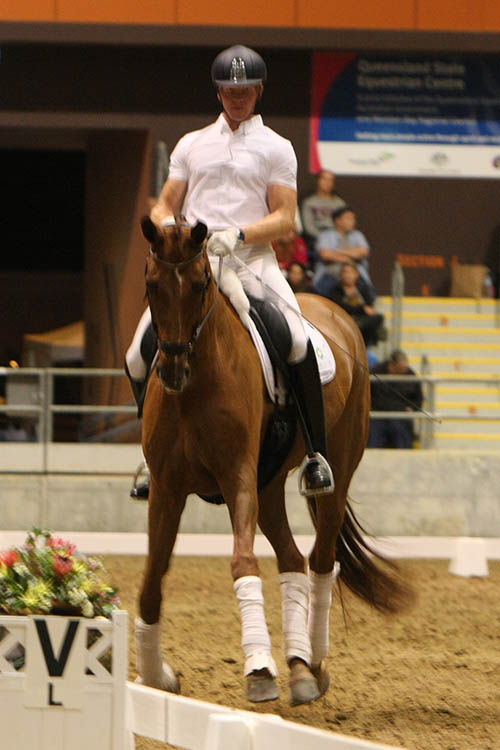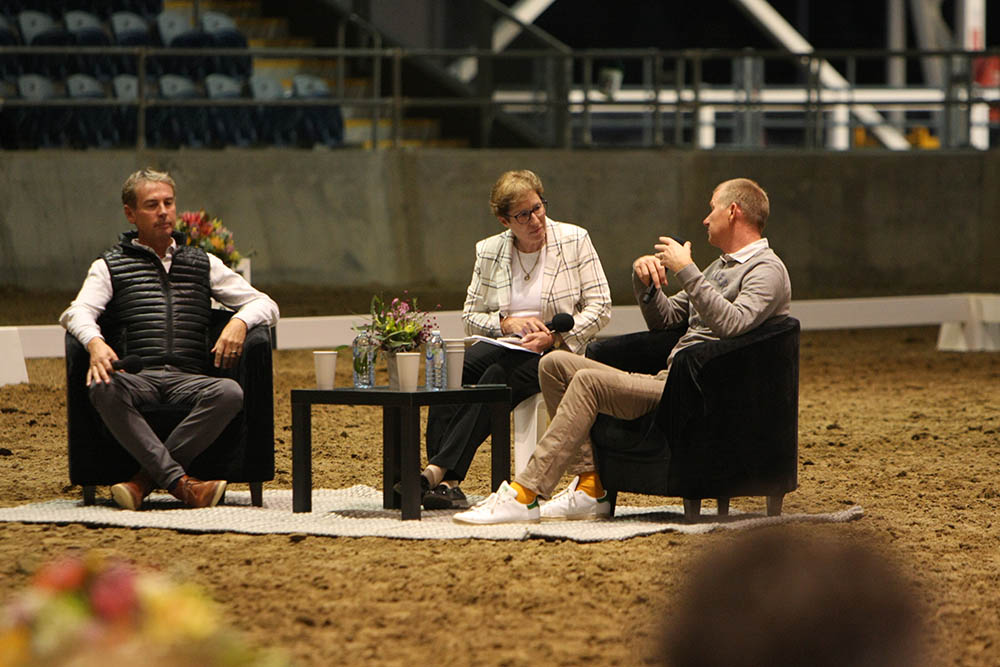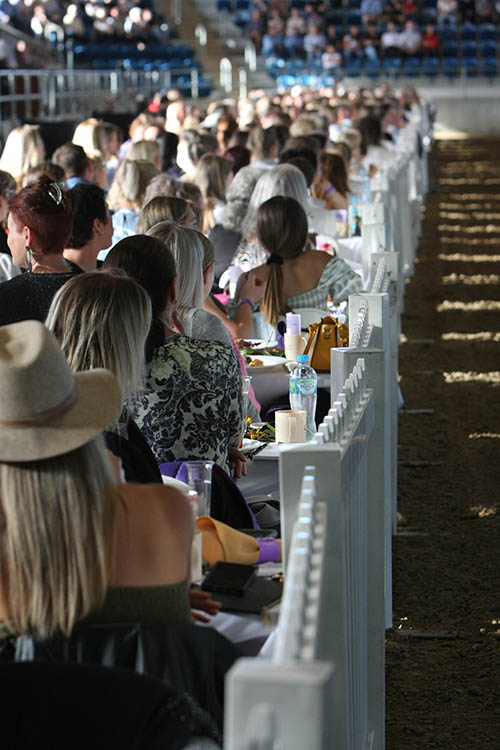The Saddleworld Carl Hester Masterclass at the Queensland State Equestrian Centre… what a production! With over 2000 spectators, it was the largest crowd to ever attend a dressage masterclass in Australia.

“Carl’s fame has
not taken an ounce of
his humility away.”
Carl Hester is one of the kindest, most down-to-earth humans in the dressage hierarchy you could come across, yet despite the management of his every move and every waking moment, he still seems to be the same Carl there was all those years ago when he was just one of the multitudes of dressage enthusiasts loving the riding and training of horses.
His proletarian start is always in his demeanour and he realises that it’s not about having millions to spend on horses, it’s more about the training and enjoying the improvement. He explains it’s more about having a good eye (or finding that expert who does) and a bit of luck along the way. He is honest about the meagre number of pounds he paid for so many horses, especially Valegro (£4,000). He never refers to his gold medal winning rides; he would rather joke about being bolted with in front of an indoor restaurant crowd enjoying a meal when trying a young dressage horse.
“It was a lovely chestnut three-year-old mare. She looked spicy, but I thought I could cope,” Carl told the QSEC crowd. “I hopped on and walked off and was fine… game to trot, as I trotted off I realised I had all my keys in the pocket of my jacket and they jangled – in hindsight, it was way more effective than any forward aid I know – and the mare made a fabulously forward transition to canter and remained more and more forward, with which the keys jangled louder and the coat flapped more and more furiously. I have never gone so fast in all my life, and despite my eyes watering with fear and from the wind velocity, I still remember heading down the long side towards the restaurant, and as I wheeled around the corner at great speed, all I could see was a myriad of wide-eyed eaters praying the glass window was horse-proof. Needless to stay, here I am alive to tell the story… and by the way, I did not buy the mare!”
Carl’s fame has not taken an ounce of his humility away. He is still the toughest and most correct critic you will come across, yet he delivers his observations with pride and humour and is never derogatory. His every intention is to improve the rapport between horse and rider and to make certain that every rider is positive in their improvement towards the greatest goal of Grand Prix. His ability to keep the balance between horse ability and rider ability, and aspirations and attitudes, is remarkable. His added wit and humble humour referring to his own shortcomings and faux pas bring this sport back to earth, making it real and understandable and thought-provoking to every rider, no matter the level.
It was then on to what everyone was waiting for – the lessons.


YOUNG HORSES
It was first in with the four- and five-year-old horses. The four-year-old Glenhill Sensation, ridden by Hannah Giblin, is a chestnut gelding by Secret who had been off the property for the first time a few weeks prior to compete in a Preliminary test. The five-year-old was a brown gelding, Senzation by Sezuan, ridden by Ruby Allen and owned by Nicole Magoffin. Senzation was formerly ridden by Harvey Beasly, where they were runner-up at the Sydney CDI and at DJWTS, and now ridden by young Ruby. They were crowned Preliminary Champion and won the five-year-old class at the recent Brisbane CDI.
It was a tricky start where neither horse wanted to enter the arena before the crowd, so Carl proceeded to explain what he looks for in a young dressage prospect. He pointed out, in no uncertain words, that the walk and the canter were the two most important paces, as you need to look where the marks are distributed in the Grand Prix test, which is in the canter work. The trot is a pace that can be more readily improved.
The most important thing in the walk was to see that the horse is able to shorten the steps and keep the four-beat rhythm. A huge over-track is not all the walk needs to have; it’s advantageous, but not if it’s so big that when you put the horse on the bit and shorten the strides it has any tendency to become lateral and lose the metronomic four equal beats. He was encouraging of the rider to use a forward moving arm to allow the horse’s nose to stretch down and forwards. When training the walk with a young horse, it’s always with the head and neck thinking forward and down and never much in the shortened stride.
Other points Carl mentioned were that young horses only need four days’ work a week as they are not strong enough mentally or physically to do more. He was very encouraging of rising trot, as again the strength over the back is lacking at that age, and if they are hot, remember to get them on the leg; if super quiet, get your leg off and teach them to be self-motivated, as nagging leg aids only make horses duller.
To help with a rider’s position, Carl suggested riding with no stirrups in the canter, quipping: “And if you are under 50, the trot as well!” He also spoke of horses that drop the contact; never throw the reins at them, he said, but take the bit up in the corner of the mouth and feel them in it. A phrase that he used sums it up perfectly: “Do not mistake emptiness for lightness.”
He was insistent that straight meant head aligned with the middle of the chest and right and left legs in line. Carl was also insistent that the horses answer the first aid and always stay sharp. Of course, he reiterated that if your horse wants to be low, then you ride more up; if too up, then down; if fast, then slow, and if slow, then forward. It was all very simplistic; there are no magic new exercises. As it always has been with Carl, the training its simply self-discipline and sticking to the principles EVERY ride.

SIX-YEAR-OLD
The next horse was the uphill bay Challenger Florian R, ridden by Rochelle King-Andrews, from the Hawkesbury in NSW. This gelding, by Fiji R from a Jive Magic x Regardez Moi mare, has been very lightly competed but won most tests he has been in at Elementary level with scores over 75%. He was reserve Elementary horse at the 2022 NSW State Championships and is about to step up to Medium level.
Carl explained that at this level it is more about working on the canter, and where the flying changes start. This horse had a well-established contact and frame that was adjustable. With the collection in the canter, Carl wanted the hind legs to feel like they were coming up under the rider’s seat, and that the steps did not get quicker and he learned to take the weight, improve the balance and, importantly, show confidence and start to relax. Carl also asked for very collected steps before the canter-to-walk transitions, with an emphasis on getting the horse to wait, then letting him down into the walk without overusing the seat – as this creates a block and a stabbing transition. The work now in the canter and transitions is important to develop strength. Keep the leg on and off, not strong and on, and do not move on to the changes until you have a confident collected canter and a clear understanding of the canter leads and their preparations.
In the canter pirouette work, to further develop the canter balance and strength, everyone talks about inside leg to outside rein, but Carl explains his pirouette aids come from outside leg to inside rein.


In the half-pass it is important to start from the beginning of the long side or from the end of the circle. Practise without setting up forever, but as it is asked in the test. There was no room with this pair for any average transitions; Carl insisted that they were all good.
An interesting exercise was to count the number of canter strides along the short side and then to realise that you have a canter you can adjust to take more or fewer steps. All this work is proving the adjustability you have, and when training alone it is something you can easily relate to, to see your ability to shorten and lengthen the strides.
Back in the trot, and it was shoulder-in then onto the diagonal, then shoulder-in again and so on. “This will help with the suppleness and this will help loosen him when you ask him to go forward,” explained Carl. “If he gets a little high in the neck then he gets behind the leg, and so get a response from the whip and leg to react forwards and then allow the neck a little as there are to be no wrinkles in front of the wither. If he gets short in the neck and a little against you, then you are responsible for the balance and this is not what we want. He must be in charge of his balance and the rider shows him how to get the balance.” He told Rochelle not to be obsessed with the trot, as it is already good with Florian, and in another year with improved strength and carrying capacity, this trot will no longer be recognisable.
Carl reminds us to give and retake the reins, something that we should all do. A good concept in thinking if a rider’s position is good is that if you took the horse away from under them, the rider would land in balance on their feet.
The crowd appreciated this wonderful horse and Rochelle’s good riding. Carl was very complimentary. It will be interesting to follow this horse’s progress and see if Carl is correct, as he is usually on the money.
MEDIUM/ADVANCED
Glencoe Torino is by AEA Tzchinski and was previously owned by Madonna Bell before current owner and rider, Isabella Wilkinson-McIntyre. Isabella has only been riding him for 18 months and training with Emma Flavelle-Watts. He is a spicy and sensitive, brown leggy gelding with an amazingly elegant and expressive trot. He is a nine-year-old and what a great type and expressive mover. Isabella is a personal trainer and a fit figure that strikes a great pose on a horse.

Carl explained that with the hotter horses, the body gets tired but the brain doesn’t. It’s well known that Carl likes his horses to spend time out in the field, as he believes that field time is important – even more so with the hot horse. Carl points out that the hotter horses – provided they aren’t too crazy – are often the workers at Grand Prix who will keep going down that final centreline. He emphasised that with these types of horses in particular, you don’t chastise them; if the horse does the wrong thing, just repeat the question.
In terms of rider position, Carl explained that with horses that aren’t great in the contact, it’s best to close your hands with your knuckles touching; if you ride with wide hands, you lower the bit in the horse’s mouth. Bringing your hands together raises them and improves the contact. In the half-pass, Carl emphasised the importance of using your weight aid by keeping your inside elbow down a little, and your outside shoulder forward.
What was an interesting thought was about the shape of the neck; Carl talked about the under-neck more than the topline. He spoke of the under-neck coming up to meet the topline!
Over and over again at all levels, he emphasised the importance of the shoulder-in to increase the engagement. Collection and the balance within this were the most important things. The travers is also a great exercise and one that needs a lot of attention. The first note is that the horse’s face should be parallel to the short side when going down the long side (i.e., if the horse ran into the wall at the end, his face would hit the wall flat… not one eye or the other!). Make sure that the outside leg is on and off, as it’s important that he moves through the ribs and a stuck-on leg won’t allow this suppleness.
Back to the walk, remembering that you are driving, not just steering. More canter work, and the aim was to try and get the strides more fluent, then place the inside hind under the inside seat bone and bring the under-neck up and develop the half-halt.

The canter was a little the weaker pace, and Carl said that Glencoe Torino must carry himself – not just the head and neck, but the whole body must sit and carry. When Carl said come back and collect, it was to be done with the upper body… and then close the leg to go forward. “He must learn to accept your leg and you need to learn how to use them!” was one of Carl’s lines of wisdom.
Glencoe Torino was a very fancy horse but had a little trouble in the changes. Carl’s advice was to simply develop a better balance and lighter self-carriage and adjustability before tackling them. A very wonderfully expressive horse with huge potential and the overall picture was very impressive. The crowd loved it. What a great compilation of honest appraisal.

SMALL TOUR
The Prix St Georges horse was Quaterbella K, ridden by Ashley Urban; they recently won the Inter I Freestyle with 72.75% at the Brisbane CDI. This mare by Quaterback is now 10, and Ashley has trained her since a four-year-old and has trained with Mel and Tor Van Den Berg and is now working on the Grand Prix movements.
Carl was correcting of rider position, as Ashley was a little chair-seated with her upper body behind the movement. He encouraged her to allow a lot more lightness in the contact to help the self-carriage and foster lightness in the horse.
Carl explained that the step up to Small Tour is one where the collection and self-carriage becomes seriously evident and shows proof of the basic training and adjustability. He really made a point that the lightness and throughness was essential, especially when you are working at this level.
He said that to look at a good collected trot, it should look like a contained medium trot. Transitions to a little passage-like trot, which was then taken forward, were brought into the trot work and always ridden through the snaffle – not the curb. The circles were divided in to four quarters and the command was to turn at each quarter and then ride forward then repeat at each quarter, and the outside rein was important here to control the shoulders. The half-halt was for only one stride then forward again.
Carl also asked for many walk-halt transitions, making the steps very short and active and lighter, so Ashley could halt square without stepping back.
With the canter, the task was to ride the shortest possible canter, basically on the spot, and when there was the feeling that it could be maintained, it could be slowly ridden forward – but not allowing heaviness to develop. To stop the mare becoming too heavy in the canter, Ashley was asked to do shorter exercises that worked at keeping the lightness – an important element when working towards Grand Prix. Interestingly, Carl noted that a horse that’s heavy in the hand is actually easier to correct than the one that is too light.
The exercise of the half-pass into the half-pirouette and back to half-pass and repeat was a great one that is timeless, as was the big walk pirouette to the canter pirouette. The feeling of getting the inside hind leg under the seat, and not to the inside, is important.
It was an honest lesson and Ashley took the constructive criticism in good faith, and the crowd really appreciated that they had the chance to see the reality of what most have trouble with, yet aren’t game to admit nor show the world.

BIG TOUR
The final session was with the Grand Prix mare Quando Queen, ridden by Robert Harrison Schmerglatt, who’s now residing in the Hawkesbury. Quando Queen is by Quaterback, with the name harking back to her great-grandfather, Kristy Oatley’s 2008 Beijing Olympic partner, Quando-Quando. This mare was imported by Robert after she was trained to Grand Prix in Germany by a good friend and partner of his. She has only made a few Grand Prix performances and was champion Inter II horse at the Australian Dressage Championships this year.
Big Tour level is now the chance to show the harmony coupled with good power that will get the marks, and of course consistent work with no mistakes… not much to ask!
By the time the horse is established at Grand Prix, the basics and way of going are established, so Carl was really about providing tips for more marks with Quando Queen. Robert asked for ideas to sort out her irregular passage, as the mare took a huge engaged step with one hind leg and nothing with the other. Carl’s way was not to try and get the short leg to get bigger, but the opposite and make the big moving hind limb step shorter. The fix was easy, and Carl asked Robert to put the mare in renvers, and only think of renvers and regularity rather than power. Once you have the regularity, then you can slowly increase the impulsion. The left hind needed to do less and so the thought was in renvers, keep the weight on the left hind leg and free the right hind leg (so renvers left). Robert was not to squeeze the leg as this caused the mare to dwell. So, instead it was to keep the leg quicker and on and off, not a squeeze. The cure was instant and so on to the next thing.


It was the walk where the mare wanted to constantly run away, especially in the extended pace, and this tended to create a loss in good rhythm. Carl’s method was to take very small steps until the mare stopped running away. It worked a treat.
Then the canter pirouette, where Robert was creating a little too much sideways with the hind legs. Carl worked on keeping the inside hind under the rider and not to the inside… instant fix! They practised the centreline with the canter in place for the pirouette, riding forward to the change and then the collected steps again. When you ride the pirouette, keep three steps either side of the centreline and keep the hind legs on the centreline. Tick that!
The tempi changes need to be centred on the diagonal line and to the marker, not before. The mare tended to slow the tempo down as the line goes on, and so Carl asked to quicken the leg aids and make her stay more on the rider. The result was easy to see.
The extended trot should not just be the front legs; an over-track is of the utmost importance. Robert was instructed not to lean back in the extended trot, but to lean forwards so the hands could allow the horse to go forward. With the upper body back, the horse will not travel forwards.
Carl’s final words were to thank all the wonderful riders for putting themselves out there for all to see on their beautifully unique horses. Carl said it makes him love these gorgeous equine friends more every time he comes here, to realise how special they all are in their own ways!
It was a great night, and despite no doubt being jet lagged given his schedule, Carl remained focused and provided fantastic exercises and made simple corrections that were so effective and easy to understand. Carl is a genius and a master, indeed. His insight into horses’ ways and riders’ abilities is next to no other. How lucky that Australians had such a chance to see him at work. What is so interesting is that for those who follow dressage seriously, there is no way of reinventing the wheel and he made this clear. It’s all the same really and the continuity of good training from the very beginning is essential.
What a treat, thanks Carl!
Carl is now almost impossible to get to see, as he is in such demand and managed within every second of his day, so thanks to all who organised such a great opportunity. Hopefully we’re able to have him back here in Australia again in the near future! EQ
YOU MIGHT ALSO LIKE TO READ:
Sabine Schut-Kery Goes With The Flow – Equestrian Life, December 2022

